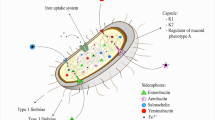Abstract
Legionella pneumophila inhabit a variety of natural and man-made aquatic environments, where they live primarily as intracellular parasites of protozoans. Given the proper exposure, however, they can cause opportunistic pneumonic infections in humans. The products of two L. pneumophila genes, dotA and mip, are part of the mechanism mediating the initial invasion of eukaryotic cells, and subsequent intracellular survival and multiplication. In this study, DNA polymorphism of the dotA and mip genes was assessed for 17 clinical and environmental isolates by nucleotide sequencing to determine the level of sequence variation, rates of molecular evolution, and history of gene divergence. The mip gene is highly conserved, whereas dotA is extremely variable, with an average level of nucleotide diversity four times greater than that of mip. Gene trees for each locus support a division of the L. pneumophila isolates into two clonal lineages. There are several disagreements between the gene trees suggesting that although L. pneumophila has a clonal population structure, genetic exchange has contributed to genotypic variation among strains in nature.
Similar content being viewed by others
Author information
Authors and Affiliations
Additional information
Received: 12 July 2001 / Accepted: 20 August 2001
Rights and permissions
About this article
Cite this article
Bumbaugh, A., McGraw, E., Page, K. et al. Sequence Polymorphism of dotA and mip Alleles Mediating Invasion and Intracellular Replication of Legionella pneumophila . Curr Microbiol 44, 314–322 (2002). https://doi.org/10.1007/s00284-01-0024-6
Issue Date:
DOI: https://doi.org/10.1007/s00284-01-0024-6




